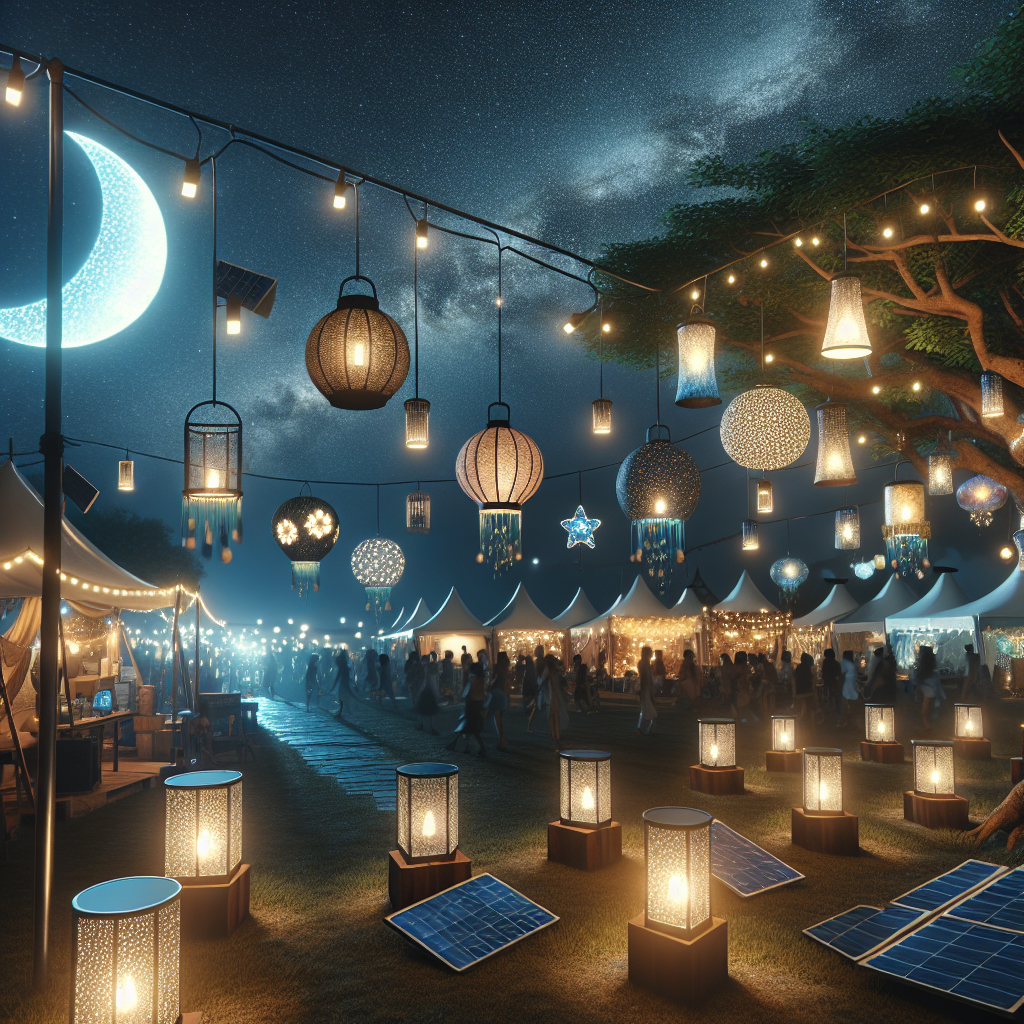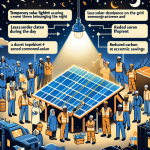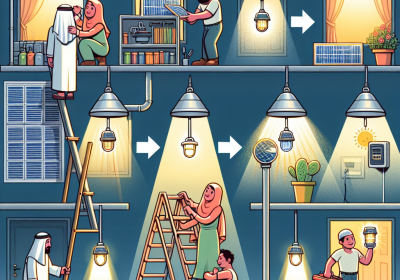Temporary Solar Lighting for Events and Festivals
-
Table of Contents
Temporary solar lighting for events and festivals offers an eco-friendly, cost-effective, and versatile solution for illuminating outdoor spaces. Utilizing solar panels to harness energy from the sun, these lighting systems provide reliable and sustainable lighting without the need for extensive wiring or a constant power supply. Ideal for a variety of settings, from music festivals and outdoor weddings to community gatherings and sporting events, temporary solar lighting enhances safety, visibility, and ambiance. With advancements in solar technology, these lighting solutions are now more efficient, durable, and capable of delivering high-quality illumination, making them an increasingly popular choice for event organizers seeking to minimize their environmental impact while ensuring a well-lit and enjoyable experience for attendees.
Benefits Of Using Temporary Solar Lighting For Outdoor Events
Temporary solar lighting has emerged as a highly beneficial solution for outdoor events and festivals, offering a range of advantages that cater to both practical needs and environmental considerations. One of the primary benefits of using temporary solar lighting is its sustainability. Unlike traditional lighting systems that rely on electricity generated from fossil fuels, solar lighting harnesses energy from the sun, a renewable resource. This significantly reduces the carbon footprint of events, aligning with the growing global emphasis on environmental responsibility and sustainability.
In addition to its eco-friendly nature, temporary solar lighting is also cost-effective. Event organizers can save on electricity costs, as solar lights do not require a connection to the power grid. This is particularly advantageous for events held in remote locations where access to electricity may be limited or non-existent. The initial investment in solar lighting equipment is often offset by the savings on energy bills and the reduced need for extensive cabling and infrastructure.
Furthermore, the ease of installation and portability of temporary solar lighting make it an ideal choice for outdoor events. Solar lights are typically designed to be lightweight and easy to set up, allowing for quick deployment and repositioning as needed. This flexibility is crucial for events that require dynamic lighting arrangements or need to adapt to changing conditions. The absence of wiring also minimizes tripping hazards and enhances the safety of event attendees.
Another significant advantage of temporary solar lighting is its reliability. Solar lights are equipped with batteries that store energy during the day, ensuring that they can provide illumination even during cloudy weather or at night. This consistent performance is essential for maintaining the ambiance and safety of outdoor events, particularly those that extend into the evening hours. Additionally, many solar lighting systems are designed to be weather-resistant, making them suitable for use in various climatic conditions.
The aesthetic appeal of solar lighting should not be overlooked. Modern solar lights come in a variety of designs and styles, allowing event organizers to create visually appealing lighting schemes that enhance the overall atmosphere of the event. From subtle pathway lights to vibrant decorative fixtures, solar lighting can be used to highlight key areas, guide attendees, and create a memorable experience.
Moreover, the use of temporary solar lighting can contribute to the positive public perception of an event. As awareness of environmental issues continues to grow, attendees are increasingly appreciative of efforts to reduce environmental impact. By choosing solar lighting, event organizers can demonstrate their commitment to sustainability, potentially attracting a more environmentally conscious audience and enhancing the event’s reputation.
In conclusion, the benefits of using temporary solar lighting for outdoor events and festivals are manifold. Its sustainability, cost-effectiveness, ease of installation, reliability, aesthetic versatility, and positive public perception make it a compelling choice for event organizers. As the demand for eco-friendly solutions continues to rise, temporary solar lighting stands out as a practical and responsible option that meets the needs of both event planners and attendees. By embracing this innovative technology, the events industry can take a significant step towards a more sustainable future.
How To Set Up Temporary Solar Lighting For Festivals

Setting up temporary solar lighting for festivals requires careful planning and execution to ensure both functionality and aesthetic appeal. The first step in this process involves selecting the appropriate solar lighting equipment. It is essential to choose high-quality solar lights that are designed for outdoor use and can withstand various weather conditions. These lights should have a sufficient battery capacity to last through the night, ensuring continuous illumination. Additionally, it is advisable to opt for lights with adjustable brightness settings to cater to different lighting needs throughout the event.
Once the equipment is selected, the next step is to conduct a site assessment. This involves evaluating the festival grounds to determine the optimal locations for placing the solar lights. Key areas to focus on include pathways, entrances, exits, and any other zones where visibility is crucial for safety and navigation. It is also important to consider the placement of solar panels to ensure they receive maximum sunlight exposure during the day. This can be achieved by positioning the panels in open areas, free from obstructions such as trees or buildings.
After the site assessment, the installation process can begin. Start by marking the locations where the lights will be installed. This can be done using stakes or flags to ensure precise placement. Next, install the solar panels in their designated spots, making sure they are securely anchored and angled correctly to capture the most sunlight. It is crucial to follow the manufacturer’s instructions during this step to avoid any potential issues with the equipment.
With the solar panels in place, the next task is to install the lights themselves. Depending on the type of lights chosen, this may involve mounting them on poles, attaching them to structures, or placing them directly on the ground. Ensure that all connections between the lights and the solar panels are secure and weatherproof to prevent any damage from rain or wind. Additionally, it is important to test each light after installation to confirm that it is functioning correctly.
To enhance the overall effectiveness of the solar lighting, consider incorporating additional features such as motion sensors or timers. Motion sensors can help conserve battery life by activating the lights only when movement is detected, while timers can be used to schedule the lights to turn on and off at specific times. These features not only improve energy efficiency but also contribute to a more sustainable event.
Maintenance is another critical aspect of setting up temporary solar lighting for festivals. Regularly check the lights and solar panels for any signs of damage or wear and tear. Clean the solar panels periodically to remove any dirt or debris that may obstruct sunlight absorption. It is also advisable to have spare batteries and replacement parts on hand in case of any malfunctions during the event.
In conclusion, setting up temporary solar lighting for festivals involves a series of well-coordinated steps, from selecting the right equipment to conducting a thorough site assessment, followed by careful installation and ongoing maintenance. By paying attention to these details and incorporating additional features like motion sensors and timers, event organizers can ensure a well-lit, safe, and environmentally friendly festival experience.
Cost-Effective Solutions With Temporary Solar Lighting For Large Gatherings
Temporary solar lighting has emerged as a cost-effective solution for illuminating large gatherings such as events and festivals. As the demand for sustainable and eco-friendly alternatives grows, organizers are increasingly turning to solar-powered options to meet their lighting needs. This shift not only aligns with global sustainability goals but also offers significant financial benefits.
One of the primary advantages of temporary solar lighting is its cost-effectiveness. Traditional lighting systems often require extensive infrastructure, including wiring, generators, and fuel. These elements can be both expensive and logistically challenging to manage, especially for large-scale events. In contrast, solar lighting systems are relatively easy to install and require minimal maintenance. The initial investment in solar panels and LED lights is quickly offset by the savings on electricity and fuel costs. Moreover, solar lighting eliminates the need for complex electrical setups, reducing labor costs and installation time.
In addition to financial savings, temporary solar lighting offers environmental benefits that are increasingly important to event organizers and attendees alike. Solar energy is a renewable resource, meaning it does not deplete natural resources or contribute to greenhouse gas emissions. By opting for solar lighting, event planners can significantly reduce the carbon footprint of their gatherings. This eco-friendly approach not only enhances the event’s reputation but also attracts a growing segment of environmentally conscious consumers.
Furthermore, the versatility of temporary solar lighting makes it an ideal choice for a variety of events and festivals. Solar lights can be easily transported and set up in remote or off-grid locations, providing reliable illumination without the need for a stable power supply. This flexibility is particularly beneficial for outdoor events, where traditional power sources may be unavailable or impractical. Additionally, solar lighting systems are designed to withstand various weather conditions, ensuring consistent performance regardless of the environment.
Another notable benefit of temporary solar lighting is its contribution to safety and security. Adequate lighting is crucial for preventing accidents and ensuring the well-being of attendees. Solar-powered lights can be strategically placed to illuminate pathways, parking areas, and other critical zones, enhancing visibility and reducing the risk of incidents. Moreover, the reliability of solar lighting ensures that events can continue smoothly even in the event of power outages or other disruptions.
While the advantages of temporary solar lighting are clear, it is essential to consider certain factors to maximize its effectiveness. Event organizers should conduct a thorough assessment of the venue to determine the optimal placement of solar panels and lights. This includes evaluating the availability of sunlight, potential shading from structures or trees, and the specific lighting requirements of different areas. Additionally, it is important to choose high-quality solar lighting products from reputable manufacturers to ensure durability and performance.
In conclusion, temporary solar lighting presents a cost-effective and environmentally friendly solution for illuminating large gatherings such as events and festivals. By reducing reliance on traditional power sources, solar lighting offers significant financial savings and contributes to sustainability efforts. Its versatility, ease of installation, and ability to enhance safety make it an attractive option for event organizers. As the demand for green alternatives continues to rise, temporary solar lighting is poised to play an increasingly important role in the successful execution of large-scale events.
Read more about Temporary Solar Lighting
- Introduction to Temporary Solar Lighting
- Advantages of Temporary Solar Lighting
- Temporary Solar Lighting for Construction Sites
- Temporary Solar Lighting for Outdoor Recreation
- Temporary Solar Lighting for Disaster Relief
- Temporary Solar Lighting for Parking Lots and Garages
- Temporary Solar Lighting for Road and Highway Construction
- Temporary Solar Lighting for Military and Security Operations
- Choosing, Installing, and Maintaining Temporary Solar Lighting









